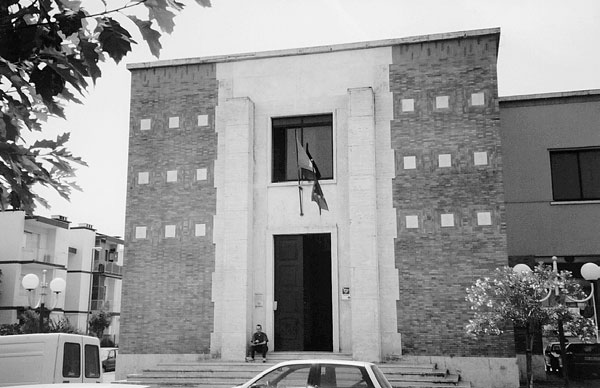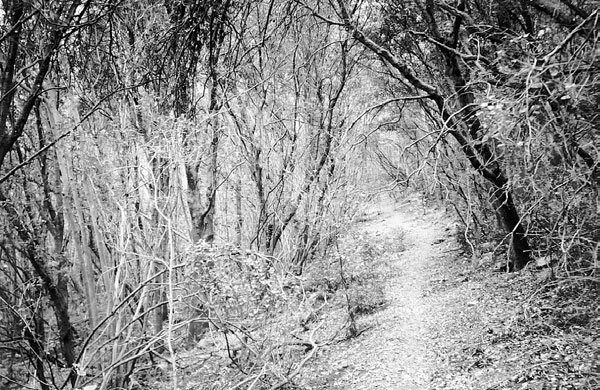Malaria and Rome: A History of Malaria in Ancient Italy (34 page)
Read Malaria and Rome: A History of Malaria in Ancient Italy Online
Authors: Robert Sallares
Tags: #ISBN-13: 9780199248506, #Oxford University Press, #USA, #History

S
CEO
Terracina
e a Lago di Paola MONTE
CIR
San Felice Circeo
Map 4. Southern Lazio
which were so lethal as a source of malaria, as Palladius understood. The interior of the Pontine forest itself, although visually intimidating, was still dangerous with regard to malaria, but not quite so dangerous. Only a small fraction of the marshes survived Mussolini’s attentions. What is left is preserved today in the Parco Nazionale del Circeo. Tito Berti, who travelled in August and commented that bad air (
aria cattiva
) began at Cisterna, described the Pontine forest in 1884 as follows:⁵
The Pontine forest creates fear and horror. Before entering it cover your neck and face well, because swarms of large bloodsucking insects are waiting for you in this great heat of summer, between the shade of the leaves, like animals thinking intently about their prey . . . Trees of every species bow towards you, stand erect in front of you, prevent you from passing: a dense network of shrubs, plants, leaves, forces you to stop: you make a path with an axe, knocking down the obstacles; and here you find a green ⁵ Attema (1993: 36–41) discussed Berti’s journey through the Pontine region.

170
Pontine Marshes
20. The Centro culturale polivalente, Via Cavour 23, in Pontinia, another of Mussolini’s new towns in the Pontine region. It houses the Museo
La malaria e la sua storia
, which documents the campaigns to eradicate malaria from the region in the 1930s.
zone, putrid, nauseating, where thousands of insects move around, where thousands of horrible marsh plants grow under a suffocating sun.⁶
This was the landscape, so close to Rome itself, which the Romans were unable to master even when they had conquered most of the rest of the then known world. To gain an idea of what that landscape was like it is necessary to resort to more recent descriptions of it, like Berti’s, because it is not described in ancient sources. From this omission significant conclusions may be drawn.
Pliny the Elder (quoted below) did indeed use the word
miraculum
, a marvel, in connection with the Pontine Marshes. Yet he failed to describe this marvel, even though it was so close to Rome. Pliny in his
Natural History
gives us countless bits of information about ⁶ T. Berti (1884),
Le Palude Pontine
, quoted by Pratesi and Tassi (1977: 137–40):
Il bosco pontino mette paura e ribrezzo. Prima di penetrarvi copritevi bene il collo e la faccia, perché nuvoli di grossi tafani vi aspettano in questa caldura, fra il rezzo delle foglie, come animali pensanti intenti alla preda . . . Alberi d’ogni specie s’incurvano verso di voi, vi spiccano dritti, vi chiudono il passo: una fitta rete d’arboscelli, di piante, di foglie, vi obbliga a fermarvi: vi fate strada con l’accetta, abbattendo gli ostacoli; ed ecco vi si presenta una zona verde, putrida, nauseante, ove corrono migliaia di insetti, ove crescono sotto un sole soffocante migliaia di orribili piante palustri
.

21. View from the
northern slopes of
Monte Circeo of the
Lago di Sabaudia
o di Paola, the most
southerly of the four
lakes stretched along
the coast of the
Pontine region behind
the coastal dunes, and
Pontine Marshes
the Selva di Circeo.
Domitian’s villa is
located on the eastern
shore of the lake.
Hare (1884: ii. 275)
made the following
observations on these
lakes: ‘they are much
frequented by the
peasants for the
fishing they afford,
but few strangers
will venture into
this plague-stricken
region’.
171

172
Pontine Marshes
22. The interior of the ilex-oak (
Quercus ilex
) forest on the relatively cool northern slopes (the Quarto Freddo) of Monte Circeo. Another species of oak tree (
Quercus cerris
) predominates in the Selva di Circeo further north in the plain.
individual plants, animals, and minerals which were of use or interest to man. However, he had no conception whatsoever of a biological environment as a community of living organisms, even though Theophrastus had already shown some insights in that direction. Moreover Pliny the Elder had less talent than his nephew, the younger Pliny, for writing about the natural landscape. Pliny the Younger described beautifully the marshes around the Lago di Bassano (
lacus Vadimonis
), but it is clear that his visit there was brief; he did not live in such environments himself.⁷ The Natural History
would have been a much better work if it had been written by Pliny the Younger instead of by his uncle. Pliny the Elder had great opportunities to provide posterity with detailed accounts of very interesting ancient ecosystems like the Pontine Marshes, which he completely squandered. The question arises of why he and most other ancient writers showed so little interest. A lot of recent scholarship on Roman attitudes to marshes and other hydraulic phenomena has attempted to extract positive attitudes ⁷ Pliny,
Ep
. 8.20.
Pontine Marshes
173
towards marshes from the ancient sources and, furthermore, to outline an ancient ideology of hydraulic management as a source of power. It is essential to ask the question of who created this ideology. It is suggested here that in so far as any positive attitudes towards marshes did exist in ancient mentalities, they were created by outsiders, people who did not live in the marshes themselves, had no first-hand experience of the extreme environmental conditions of marshlands, and consequently did not suffer from the endemic malaria whose enormous demographic impact on human populations living in marshland environments is now well known to specialists in historical demography (Ch. 5. 4 above). It is because the ideology of the management of wetlands was created by outsiders that we cannot hope to find in ancient sources the level of detail, found in more recent descriptions such as Berti’s, which would suggest anything much in the way of personal acquaintance with life and environmental conditions in marshlands. At least the description of a painting of a marsh given by Philostratus may have some literary merit, even though its failure to allude in any way to ‘bad air’ demonstrates its fundamental lack of realism. The writing about marshes of the late Roman author Vibius Sequester is so impoverished that it hardly merits quotation.⁸
The extreme poverty of his text, a brief list of names and locations with a handful of extremely short notes of mythological interest, scarcely needs any commentary. Let us return to the early modern descriptions. Different visitors arrived at different times of the year and saw different parts of the Pontine region. Thus it is possible to find quite different accounts of the area. Gregorovius provides an interesting contrast to the already quoted passage from Berti:
He who has traversed the Pontine Marshes as far as Terracina by the Via Appia will have a most mistaken idea of them if he imagines that they are loathsome swamps. Morasses and ponds do exist, but they lie hidden away in the woods, where the hedgehog, the stag, the wild boar, the ⁸ Vibius Sequester,
de fluminibus fontibus lacubus nemora paludes
, etc., ed. Parroni (1965):
5.
PALUDES,
1
Ambracia Achaiae
. 2
Asia Asiae, cui Caystros prope est
. 3
Camerina nunc, ante Hyperie dicta, Syracusis
. 4
Lerna Arcadiae, unde hydra centum capitum, quam Hercules occidit
. 5
Maeotis Scythiae
.
6
Pomptinae Tarracinae, Foro Appi
. 7
Padu
〈
s
〉
ae Galliae a Pado dictae
. 8
Styx inferorum a Styge Oceani filia
. 9
Satura inter Antium et Cerce
〈
i
〉
os, eadem Stura
. 10
Strymon Thraciae
. 11
Salpina in Hadriatico
. 12
Triton Thraciae, in quo se novies merserit in avem convertitur
. 13
Tyraca Syracusis
. Traina (1986) and (1988: 107, 112) on Vibius Sequester; Leveau (1993) and Purcell (1996) for the ideology; Philostratus,
imagines
1.9, ed. Kayser (1871).
174
Pontine Marshes
buffalo, and the half-wild cattle may still be found. In May and June this Pontine territory is a sea of flowers, poured out, as far as the eye can reach, over this whole land. In the heat of summer, it is true, it becomes a Tartarus, where pale fever creeps around to torture the poor herdsman or labourer, who must earn his bread in suffering, and cannot fly from its pestilential air.⁹
Tartarus! A far cry from the idyllic view of Mediterranean wetlands found in the writings of some modern historians. Gregorovius, unlike Berti, does not describe the Pontine forest. He also travelled around 1860 in summer (at a time when most travellers to Rome went there between November and April¹⁰) and saw the region at the time of year when large areas, which were flooded in winter, had dried out for summer. Nevertheless Gregorovius was right that the areas which dried out seasonally were the ones which were most dangerous with regard to malaria. They were the breeding sites of the mosquito species
Anopheles labranchiae
, which was extremely common in this area, while the forested areas and the brackish lakes along the coast were the domain of
A. sacharovi
, another very dangerous vector of malaria. A third mosquito species, the zoophilic
A. messeae
, also occurred in some of the same localities as
A. labranchiae
, but in much smaller populations. Doni also regarded coastal forests as unhealthy in the seventeenth century.¹¹
Hans Christian Andersen described the Pontine Marshes as follows:
Many people imagine that the Pontine Marshes are only marshy ground, a dreary extent of stagnant, slimy water, a melancholy road to travel over: on the contrary the marshes have more resemblance to the rich plains of Lombardy; yes, they are like them, rich to abundance; grass and herbage grow here with a succulence and luxuriance which the north of Italy cannot exhibit . . . the immense plain stretches itself out with its tall grass, and its fresh, green marsh-plants. Canals cross one another, and drain off the water which stands in ponds and lakes covered with reeds and ⁹ Gregorovius (1902: 279).
¹⁰ A more typical example of the early modern travellers was the famous nurse Florence Nightingale, who arrived in Rome in early November 1847 and departed at the end of March 1848 (Keele (1981) ). She toured the hospitals of Rome, including the Santo Spirito hospital which accommodated patients with malaria, and noted the atrocious conditions prevailing in them. Blewitt (1843: 466) noted that few travellers stayed in Rome during the summer.
¹¹ De Muro (1933); Doni (1667: 101).
